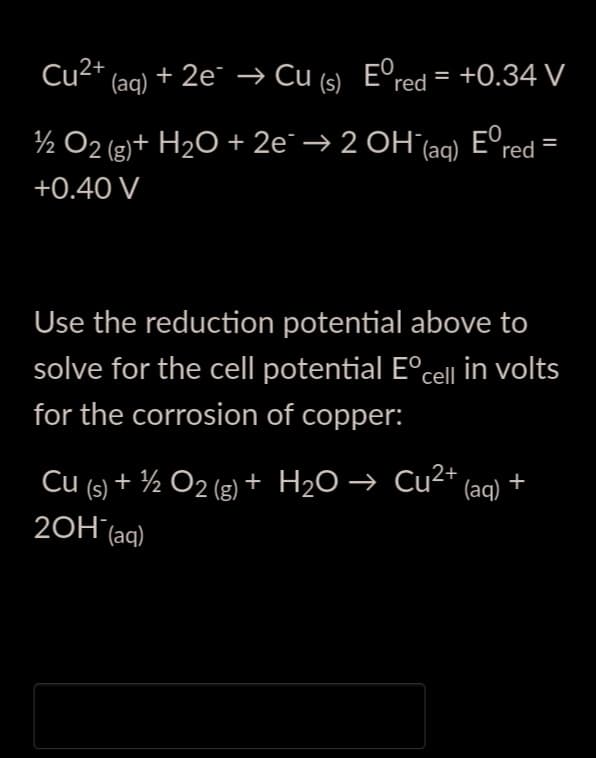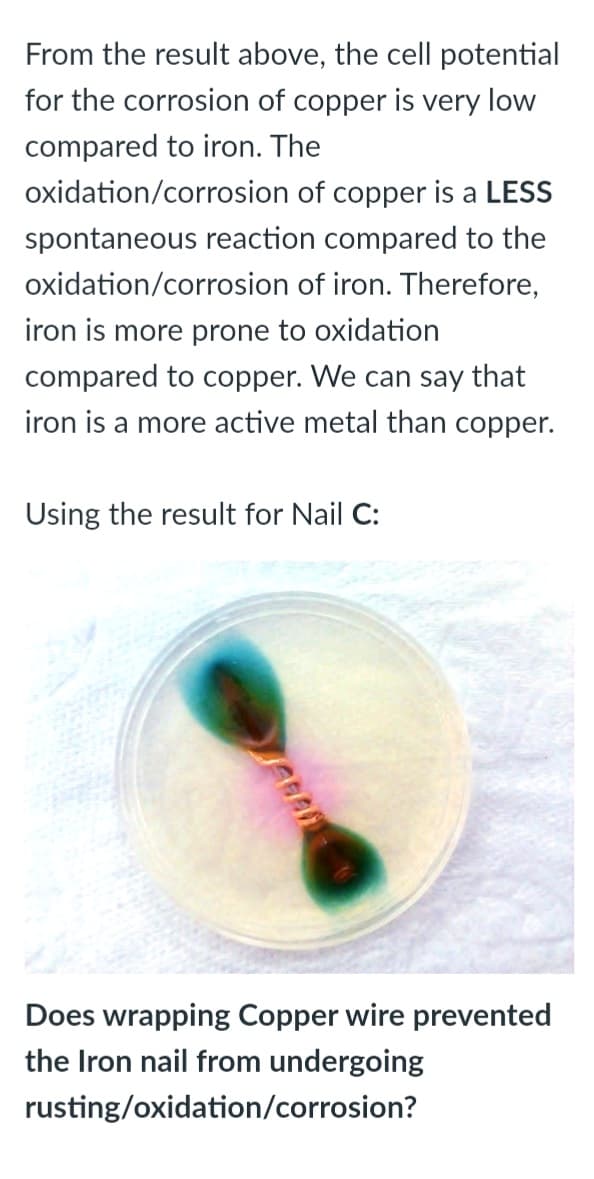Cu2* (aq) + 2e → Cu (s) E°red = +0.34 V ½ O2 (g)+ H2O + 2e* → 2 OH(aqg) E°red +0.40 V Use the reduction potential above to solve for the cell potential E°cell in volts for the corrosion of copper: Cu (s) + ½ O2 (g) + H2O → Cu²+ 20H´(aq) (aq) +
Cu2* (aq) + 2e → Cu (s) E°red = +0.34 V ½ O2 (g)+ H2O + 2e* → 2 OH(aqg) E°red +0.40 V Use the reduction potential above to solve for the cell potential E°cell in volts for the corrosion of copper: Cu (s) + ½ O2 (g) + H2O → Cu²+ 20H´(aq) (aq) +
Chapter18: Introduction To Electrochemistry
Section: Chapter Questions
Problem 18.19QAP
Related questions
Question
Please state the explanation and answers clearly.

Transcribed Image Text:Cu2* (aq) + 2e → Cu (s) E°red = +0.34 V
%3D
E°red
½ O2 (g)+ H2O + 2e¯ → 2 OH(aq)
+0.40 V
Use the reduction potential above to
solve for the cell potential E°cell in volts
for the corrosion of copper:
Cu (s) + ½ O2 (g) + H2O → Cu²+
20H´(aq)
(aq) *
+

Transcribed Image Text:From the result above, the cell potential
for the corrosion of copper is very low
compared to iron. The
oxidation/corrosion of copper is a LESS
spontaneous reaction compared to the
oxidation/corrosion of iron. Therefore,
iron is more prone to oxidation
compared to copper. We can say that
iron is a more active metal than copper.
Using the result for Nail C:
Does wrapping Copper wire prevented
the Iron nail from undergoing
rusting/oxidation/corrosion?
Expert Solution
This question has been solved!
Explore an expertly crafted, step-by-step solution for a thorough understanding of key concepts.
This is a popular solution!
Trending now
This is a popular solution!
Step by step
Solved in 4 steps

Follow-up Questions
Read through expert solutions to related follow-up questions below.
Follow-up Question
What's the answer for the second picture?
The choices are yes or no.
Solution
Knowledge Booster
Learn more about
Need a deep-dive on the concept behind this application? Look no further. Learn more about this topic, chemistry and related others by exploring similar questions and additional content below.Recommended textbooks for you


Chemistry: An Atoms First Approach
Chemistry
ISBN:
9781305079243
Author:
Steven S. Zumdahl, Susan A. Zumdahl
Publisher:
Cengage Learning

Chemistry: Principles and Reactions
Chemistry
ISBN:
9781305079373
Author:
William L. Masterton, Cecile N. Hurley
Publisher:
Cengage Learning


Chemistry: An Atoms First Approach
Chemistry
ISBN:
9781305079243
Author:
Steven S. Zumdahl, Susan A. Zumdahl
Publisher:
Cengage Learning

Chemistry: Principles and Reactions
Chemistry
ISBN:
9781305079373
Author:
William L. Masterton, Cecile N. Hurley
Publisher:
Cengage Learning

Principles of Modern Chemistry
Chemistry
ISBN:
9781305079113
Author:
David W. Oxtoby, H. Pat Gillis, Laurie J. Butler
Publisher:
Cengage Learning

Chemistry: The Molecular Science
Chemistry
ISBN:
9781285199047
Author:
John W. Moore, Conrad L. Stanitski
Publisher:
Cengage Learning

General Chemistry - Standalone book (MindTap Cour…
Chemistry
ISBN:
9781305580343
Author:
Steven D. Gammon, Ebbing, Darrell Ebbing, Steven D., Darrell; Gammon, Darrell Ebbing; Steven D. Gammon, Darrell D.; Gammon, Ebbing; Steven D. Gammon; Darrell
Publisher:
Cengage Learning